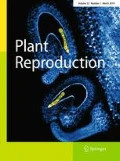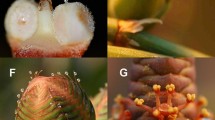Abstract
The pollination droplet is a highly conservative pollination mechanism that is observed in all major gymnosperm taxa. Proteomics analysis of the pollination drops was carried out on four gymnosperm species: Juniperus communis (common juniper), Juniperus oxycedrus (prickly juniper), Chamaecyparis lawsoniana (Port Orford cedar), and Welwitschia mirabilis. Pollination drop proteins were purified by SDS-PAGE, and the most abundant proteins were analyzed by mass spectrometry and sequenced. Based on BLAST searching of combined amino acid sequences, the following proteins were identified in the following species: an 83-kDa subtilisin-like proteinase, a 62-kDa glycosyl hydrolase, a 47.5-kDa glucan 1,3-β-glucosidase precursor, a 30-kDa chitinase, and a 25-kDa thaumatin-like protein were identified in J. communis; a 30-kDa chitinase, a 25-kDa thaumatin-like protein, and a 32.5-kDa glucanase-like protein were identified in J. oxycedrus; an 83-kDa subtilisin-like proteinase, a 62-kDa β-d-glucan exohydrolase, a 47.5-kDa glucan 1,3-β-glucosidase, and two 25-kDa thaumatin-like proteins were identified in C. lawsoniana, and a 25-kDa chitinase was identified in W. mirabilis. Based on protein identifications, there is strong evidence that the pollination drop functions in both pathogen defense and pollen development. The discovery of similarities in terms of peptide sequence and protein identifications indicates that ovular secretions are functionally conservative, and that they are essential to reproductive success.

Similar content being viewed by others
References
Carafa A, Carratù G, Pizzolongo P (1992) Anatomical observations on the nucellar apex of Welwitschia mirabilis and the chemical composition of the micropylar drop. Sex Plant Reprod 5:275–279
Cheong NA, Choi YO, Kim WY, Kim SC, Cho MJ, Lee SY (1997) Purification of an antifungal PR-5 protein from flower buds of Brassica campestris and cloning of its gene. Physiol Plant 101:583–590
Cheong YH, Kim CY, Chun HJ, Moon BC, Park HC, Kim JK, Lee S, Han C, Lee SY, Cho MJ (2000) Molecular cloning of a soybean class III β-1,3-glucanase gene that is regulated both developmentally and in response to pathogen infection. Plant Sci 154:71–81
dos Santos ALW, Wietholter N, El Gueddari NE, Moerschbacher BM (2006) Protein expression during seed development in Araucaria augustifolia: transient accumulation of class IV chitinases and arabinogalactan proteins. Physiol Plant 127:138–148
Duhoux E, Pham Thi A (1980) Influence de quelques acides aminés libres de l’ovule sur la croissance et le développement cellulaire in vitro du tube pollinique chez Juniperus communis (Cupressacées). Physiol Plant 50:6–10
Gelbart G, von Aderkas P (2002) Ovular secretions as part of pollination mechanisms in conifers. Ann For Sci 59:345–357
Habermann B, Oegema J, Sunyaev S, Shevchenko A (2004) The power and the limitations of cross-species protein identification by mass spectrometry-driven sequence similarity searches. Mol Cell Proteomics 3:238–249
Hruba P, Honys D, Twell D, Capkova V, Tupy J (2005) Expression of β-galactosidase and β-xylosidase genes during microspore and pollen development. Planta 220:931–940
Kasprzewska A (2003) Plant chitinases–regulation and function. Cell Mol Biol Lett 8:809–824
Koiwa H, Kato H, Nakatsu T, Oda J, Yamada Y, Sato F (1999) Crystal structure of tobacco PR-5d protein at 1.8 Å resolution reveals a conserved acidic cleft structure in antifungal thaumatin-like proteins. J Mol Biol 286:1137–1145
Laemmli UK (1970) Cleavage of structural proteins during the assembly of the head of bacteriophage T4. Nature 227:680–685
Lawton KA, Beck J, Potter S, Ward E, Ryals J (1994) Regulation of cucumber class III chitinase gene expression. Mol Plant Microbe Interact 7:48–57
Liska AJ, Shevchenko A (2003) Expanding the organismal scope of proteomics: cross-species protein identification by mass spectrometry and its implications. Proteomics 3:19–28
Mauch F, Mauch-Mani B, Boller T (1988) Antifungal hydrolases in pea tissue. II. Inhibition of fungal growth by combinations of chitinase and β-1,3-glucanase. Plant Physiol 88:936–942
McWilliam JR (1958) The role of the micropyle in the pollination of Pinus. Bot Gaz 120:109–117
Moffatt B, Ewart V, Eastman A (2006) Cold comfort: plant antifreeze proteins. Physiol Plant 126:5–16
O’Leary SJB, Joseph C, von Aderkas P (2004) Origin of arabinogalactan proteins in the pollination drop of Taxus × media. Aust J For Sci 121:35–46
O’Leary SJB, Poulis BAD, von Aderkas P (2007) The identification of two thaumatin-like proteins (TLPs) in the pollination drop of hybrid yew that may play a role in pathogen defence during pollen collection. Tree Physiol 27:1649–1659
Owens JN, Blake MD (1984) The pollination mechanism of Sitka spruce (Picea sitchensis). Can J Bot 62:1136–1148
Owens JN, Simpson SJ, Caron GE (1987) The pollination mechanism of Engelmann spruce, Picea engelmannii. Can J Bot 65:1439–1450
Poulis BAD, O’Leary SJB, Haddow JD, von Aderkas P (2005) Identification of proteins present in the Douglas fir ovular secretion: an insight into conifer pollen selection and development. Int J Plant Sci 166:733–739
Regalado AP, Pinheiro C, Vidal S, Chaves I, Ricardo CPP, Rodrigues-Pousada C (2000) The Lupinus albus class-III chitinase gene, IF3, is constitutively expressed in vegetative organs and developing seeds. Planta 210:543–550
Roggen HPG, Stanley RG (1969) Cell wall hydrolyzing enzymes in wall formation as measured by pollen tube extension. Planta 84:295–303
Schaller A (2004) A cut above the rest: the regulatory function of plant proteases. Planta 220:183–197
Selitrennikoff CP (2001) Antifungal proteins. Appl Environ Microb 67:2883–2894
Séridi-Benkaddour R, Chesnoy L (1988) Secretion and composition of the pollination drop in Cephalotaxus drupacea (Gymnosperm, Cephalotaxaceae). In: Cresti M, Gori P, Pacini E (eds) Sexual reproduction in higher plants. Springer, Berlin, pp 345–350
van Hengel AJ, van Kammen A, de Vries SC (2002) A relationship between seed development, arabinogalactan-protein (AGPs) and the AGP mediated promotion of somatic embryogenesis. Physiol Plant 114:637–644
Walden AR, Walter C, Gardner RC (1999) Genes expressed in Pinus radiata male cones include homologs to anther-specific and pathogenesis response genes. Plant Physiol 121:1103–1116
Xing S, Chen Z, Hu Y, Zhou F, Lin J (2000) Ovule development, formation of pollination drop and pollination process in Taxus chinensis (Taxaceae). Acta Bot Sin 42:126–132
Ziegler H (1959) Über die Zusammensetzung des “Bestäubungstropfens” und Mechanismus seiner Sekretion. Planta 52:587–599
Acknowledgments
We are grateful to Leslie Elliott, Jerry Hill, Scott Kolpak, Angelia Kegley, and Jerry Berdeen at the Dorena Lake GRC for allowing us to sample from C. lawsoniana, and to Doug Ewing at the University of Washington greenhouse for allowing us to sample from W. mirabilis. We would also like to thank Derek Smith, Leanne Ohlund, and Phil Jakubowski at the University of Victoria Genome BC Proteomics Centre for analytical support. Special thanks to Andrea Coulter, Adrienne Robb for many hours of sample collection from C. lawsoniana and W. mirabilis. This work was sponsored by the Natural Sciences and Engineering Research Council of Canada (NSERC).
Author information
Authors and Affiliations
Corresponding author
Additional information
Communicated by Yongbiao Xue.
Rights and permissions
About this article
Cite this article
Wagner, R.E., Mugnaini, S., Sniezko, R. et al. Proteomic evaluation of gymnosperm pollination drop proteins indicates highly conserved and complex biological functions. Sex Plant Reprod 20, 181–189 (2007). https://doi.org/10.1007/s00497-007-0054-8
Received:
Revised:
Accepted:
Published:
Issue Date:
DOI: https://doi.org/10.1007/s00497-007-0054-8




